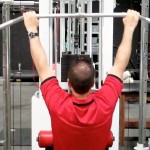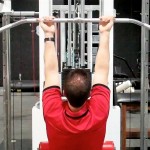Brian Schiff’s Blog
Injury Prevention, Sports Rehab & Performance Training Expert
I am big fan of lat pull downs and pull-ups. I think when done properly, this is a fantastic way to improve postural strength and safeguard the shoulder against injury. In April 2012, I wrote a column on lat pull downs addressing shoulder pain (click here to read that post).
I decided to add to that previous post and discuss a recent article published in the February NSCA Strength and Conditioning Journal. In the article, the authors present some research regarding how altering hand orientation and grip width affects muscle activity during the exercise.
Grip Width Summary
Lehman J Strength Cond Res 2005
- No significant difference between narrow supinated grip and wide pronated grip with biceps and latissimus dorsi
- Highest level of latissimus dorsi activity occurs with seated row with retracted shoulders
Lusk et al. J Strength Cond Res 2010
- No difference in biceps, latissimus or middle trapezius activity (note – wide grip only slightly larger than narrow grip)
Sperandei et al. J Strength Cond Res 2009
- In front of the head pull downs with standardized width and hand orientation revealed higher activation for posterior deltoid and latissimus compared to behind the neck
- This study did NOT compare different grip widths
Hand Orientation Summary
Youdas et al.J Strength Cond Res 2010
- Pronated grip during pull-ups (56 +/- 21% MVIC) was most effective for activating the lower trapezius compared with the supinated grip
- Pronated grip also resulted in greater infraspinatus activation (45 +/- 22% MVIC) compared with the perfect pull-up
- Perfect pull-up showed higher latissimus activity (130 +/- 53% MVIC) than the supinated grip of a chin up
- Supinated grip of the chin-up revealed an increase in pec major (57 +/- 36% MVIC) and biceps brachii (96 +/- 34% MVIC) versus 44 +/- 27% (pec major) and 78 +/- 32% (biceps brachii) for the pronated version
- Posterior deltoid showed no difference in all hand orientations
Lusk et al. J Strength Cond Res 2005
- Pronated grip during lat pull-downs elicited a 9% greater muscle activation of latissimus dorsi compared to supinated grip
- No difference between middle trapezius and biceps brachii in pronated or supinated grip
My Takeaways
- If your goal is maximizing latissimus activity and improving scapular stabilizer and rotator cuff function opt for the pronated grip
- Supinated grip elicits greater activation in the pectoralis major and biceps – no surprise here based on physics and kinesiology -> easier for clients to do and also not going to stress the shoulder as much in the presence of any inflammation or pathology
- Range of motion, scapular dyskinesia, pain, soft tissue restrictions and imbalances play a vital role for each client so they may need some preparatory work to make the most of this exercise
- Small tweaks (in my opinion) can make a big difference in comfort level and performance of the exercise (refer to number 3 for why) so do not be afraid to experiment between wide and narrow in a pronated grip
- The authors mention that if individuals elect to do the behind the neck version they should have adequate range of motion to do it safely. Let me be clear – there is NO reward big enough to justify the risk involved in doing behind the neck pull-downs. Save your neck and shoulders by eliminating this option altogether as I would bet most of us do not have perfect bony anatomy, mobility and optimal muscle firing throughout the motion to ensure that potential repetitive micro trauma will not occur over time.
For my CrossFit friends – optimal shoulder mobility, scapular stability and adequate thoracic spine extension and rotation is a must to minimize risk with kipping and less than perfect pulling form. I much prefer unweighting or assisting the body through pull downs, bands or partner assists to build pre-requesite strength initially until the client is better able to manage the movement under full body weight.
Quality movement ABSOLUTELY matters over hundreds and thousands of reps.
As far as research goes, I think we still need further studies on grip width and specifically how it may directly impact not only muscle activation but force on the glenohumeral joint itself. For me, I opt for pronated pull-ups and or pull-downs once per week with a moderate grip width in my own routine. I hope this information serves you well. Happy lat training!!
One of the most common issues I see in the clinic with active exercise enthusiasts between the age of 20 and 55 is shoulder pain. Weightlifting has been popular for ages, but Crossfit is all the rage these days. Both disciplines involve overhead lifts. The key thing to remember when performing overhead repetitive lifts is how load and stress not only affects strength and power, but how it impacts the joint itself.
Pull-ups and pull-downs are staples for most clients I see. As a therapist and strength coach, I am always thinking and analyzing how variables such as grip, grip width, arm position, scapular activation, trunk angles etc influence exercise and how force is absorbed by the body. One such exercise I have spent time studying and tweaking is the lat pull-down.
Consider for a moment how width and grip impacts the relative abduction and horizontal external rotation in the shoulder at the top and bottom of the movement in the pictures below (start and finish positions are vertically oriented):
It should be common knowledge for most, but I will state it for the record anyway – you should NEVER do behind the neck pull-downs. Beyond the horrible neck position, this places the shoulder in a dangerous position for impingement and excessively stresses the anterior shoulder capsule. A wider grip (be it with pull-ups, pull downs, push-ups) will always transfer more stress to the shoulder joint because you have a longer lever and greater abduction and horizontal external rotation.
So, what bearing does this have in relation to the rotator cuff and SLAP injuries? For more information and details on the application of the grip choice, click here to read the full column I did for PFP Magazine this month. Stay tuned for my next post (a follow-up to this one) one of my Crossfit patients who now only has pain with overhead squats and how my differential diagnosis and rehab has led me to conclude what is wrong with his shoulder. Keep in mind we must learn to train smarter so we can train harder and longer without pain and injury. Biomechanics and understanding your own body really does matter.









